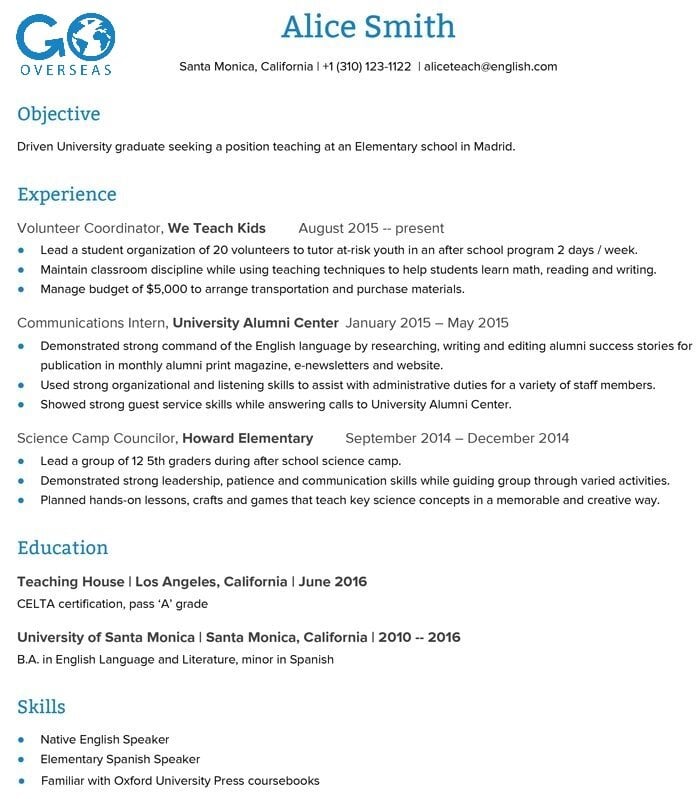How to Create an ESL Teacher Resume that Will Get You the Job
No matter where your overseas journey takes you, there’s one important document you’ll need to help you land that coveted teaching position: a job-scoring ESL teacher resume.
Key Takeways 🔑
- A killer ESL teacher resume can help you land the job of your dreams.
- Using a template is a great place to start if you have never created a teaching resume.
- Make sure to hit on several key points to highlight the things employers want to see.
- Don't be afraid to get creative when crafting your ESL teacher resume.

Whether you are planning to move to the snow-peaked caps of the Chilean Andes, the rolling deserts of Saudi Arabia, or the smart city streets of Rome, there’s an important document you’ll need to help you land a coveted teaching position abroad: a resume.
It should come as no surprise that in order to teach English overseas, as is the case for the majority of jobs out there, you will need to prove your qualifications. The standard way to do this is through a resume. Though submitting a resume may not necessarily be the first step in your journey toward teaching abroad, most all programs use this tool at some stage in the process as an effective way to evaluate your preparedness for such a position.
Writing a resume can be a difficult task even when you have a ton of experience in the field, and it can be even more daunting if your prior teaching experience is limited. But whether you’ve spent several years teaching or have never set foot in a classroom, there's a way to craft a resume that demonstrates your teaching potential to future employers.
How do I write an ESL resume with no experience?
If you're new to the ESL world and looking to land your first job, you may be wondering how to write a resume with no teaching experience. You'll need to get a little creative but the key is transferable skills.
Transferable skills are skills you gained through other unrelated jobs that can be applied to teaching. There are hard and soft skills that are relevant in the classroom that are used across a lot of different fields, whether you worked in retail or finance. We talk about these skills more below.
You can also include other relevant experiences outside of the workplace, including volunteering, interning, studying, and even a gap year.
Check out guides on how to include these experiences here:
Writing your resume: the basics
No matter what industry, there are a few general requirements that every resume should follow.
Contact information: Your resume should have your name and contact details clearly stated at the top of the page so your prospective employer can contact you easily. For security reasons, avoid adding your full address. A city, state, and country will suffice.
Formatting: When it comes to fonts and colors, stay with simple fonts such as Times New Roman, Arial, or Garamond, and professional colors such as black, dark gray, or navy blue. Sticking to a white background for your document is also a good rule of thumb to follow.
Photo: Although this is not done in the US due to anti-discrimination laws, it is common practice to include a phone on your resume in several countries including EFL powerhouses like China and Japan. Photos should be professional-looking, simple headshots.
Professionalism: It is of the utmost importance that you spell-check the document. It should also go without saying that you should never lie on a resume. Don’t include experiences, titles, or skills that you don’t actually possess.
Start with a resume template
You can certainly format your own resume but it might be easier to start with a fillable template. There are several free options to explore.
- Google Docs: use one of Google's five pre-existing templates or find free templates online like these from ResumeGenuis.
- Microsoft Word: Word also has templates for users to fill in with their own information. ResumeLab has over 50 free stunning templates to download and edit in Word.
- Canva: beautiful customizable templates in Canva's easy-to-use drag and drop format.
1. State a clear objective
The first section we recommend you include on your resume -- after your name and contact details -- is an objective. Only one to three sentences in length, this section is a succinct way to summarize yourself as a candidate and your intentions in submitting your resume for a certain position.
Of course, this section needs to be tailored to each specific job you apply for, for example: to obtain a position teaching English to elementary school students in Madrid or highly skilled ESL Teacher with five years experience who seeks a position at ABC institute in Qatar.
2. List relevant experience
The experience section is perhaps the most important section of your resume, as it provides potential employers with the meat of why you are a great candidate. This is where you will want to list your current and past employment as well as relevant fieldwork, leadership experiences, or volunteer work.
Be sure to include your position title, the company or organization name, dates of employment/affiliation, and a description of your responsibilities, duties, and key skills.
As far as order is concerned, traditionally resumes include the most recent experience at the top, with the rest listed in chronological order. However, if you have experiences that are more relevant than your current ones you can also list positions in order of their relevance.
Be specific!
You want to be specific and, if possible, quantify your past experiences. Prospective employers love to see results and this is your time to show off your impressive accomplishments. Be sure to include responsibilities that go above and beyond, as well. Some examples of how to do this include:
- Taught a test prep class with 100% pass rate among students
- Maintained a class average of 85% during 2020-2021 school year
- Volunteered to lead after-school tutoring sessions for 15 students
Tip: read through the job description and place key skills, experiences, or verbs in the requirements section into the descriptions of the experiences you list. This not only makes it easier for you to figure out how to write about your experiences, but it also helps employers identify that your experiences match what they are looking for.
3. Showcase your educational attainment
Where you put this section will depend on where you are in your career. If you are a recent graduate without a lot of work experience, you may want to highlight this at the top of your resume. Alternatively, if you have several years of work under your belt, it's better to push it to the bottom. In this section, you can list both your university degree and TEFL certification.
If you have a college degree, be sure to include your university name, degree program, graduation date (or anticipated date if you haven't graduated yet), and GPA. If you graduated with a low GPA, it's OK to leave it out.
Any relevant certifications should be included, too. If you have any teaching certifications, like a TEFL certification, or others that can help in the classroom such as first aid, you can place these below your university degree(s).
4. Show off your skills
The skills section is another place where you can concisely list the relevant skills you have that will help you succeed in a teaching position. You can list both hard and soft skills.
Hard skills
Hard skills generally refer to abilities and expertise needed to perform tasks on the job. These skills can be learned and added to your resume as you level up.
Examples of relevant hard skills are:
- Technical skills (ex. PowerPoint, Google Sheets, Blackboard)
- Computer skills (ex. Windows, OS)
- English language proficiency
- Proficiency in other languages
- Writing/editing
Soft Skills
Soft skills refer to your personal qualities and interpersonal skills that will help you to fit in and get along well with others in the workplace.
Examples of relevant soft skills are:
- Communication
- Patience
- Teamwork
- Time management
- Adaptability
5. Do a final once-over
Before you hit the send button on that email (or electronic application), there are a few things you'll want to double-check. Here’s a final checklist:
- Is your name and contact information clearly displayed at the top of the resume?
- Do the fonts, color choices and layout accurately reflect you as a professional candidate?
- Have you read through the document (and spell checked) to ensure the resume is free from grammar or spelling errors?
- Is your objective specific to the job you are applying for?
- Have you included all relevant skills that would be useful in convincing a future employer that you are the best candidate for the job?
Putting it all together
After reading all our advice we want to share an example resume with you so that you can better visualize all that we’ve discussed:

A note on resume creativity

Resumes are all about the spin. Regardless of the field of your past experiences, you can find a way to spin them so that the skills you learned and qualities that are relevant to teaching English stand out.
For starters, include any experiences that you have working with students in the age range of the position. Even if they aren't in-classroom experiences, noting that you have tutored fellow classmates, been a camp counselor at summer camp, or babysat on the weekends are all examples of experiences that demonstrate your skills with children and youth.
It's also important you demonstrate any leadership experiences you have that can carry on to your skills teaching in the classroom. Were you president of a school club? Served as first chair violinist in your high school orchestra? Organized a trash pick-up day for residents of your dorm? Led a class debate team to victory? Write those down.
Of course, as you're applying for a position teaching English, include any English language experiences as well, such as writing for a student newspaper, involvement in a poetry club, or taking journalism or literature courses at your university.
Get the job of your dreams
Resume writing can be stressful, especially when you're just getting started in your teaching career. Don't get discouraged though as you continue to build and polish your resume, it's a continuous work in progress. By following our tips, you'll be on your way to securing a great job that will take you to new and exciting places!
